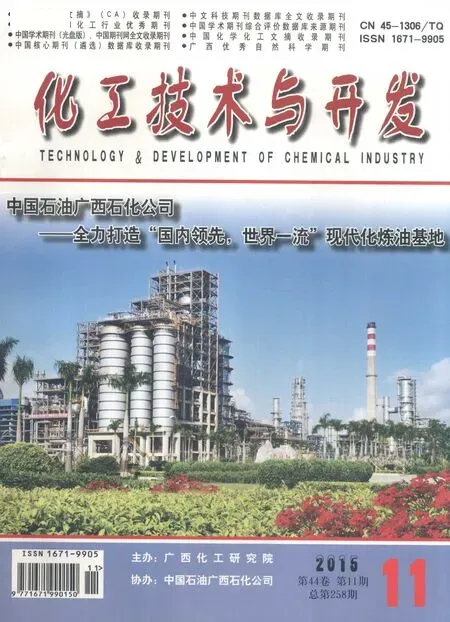含杂原子羧酸类有机锡化合物的结构研究
2015-10-25吕惠萍
朱 琪,吕惠萍
(菏泽学院化学化工系,山东 菏泽 274015)
具有多个供电中心的二齿或者多齿的含有N、O、S 原子的配体能够使有机锡化合物呈现十分复杂、有趣的结构,在得到的这些配合物中不仅配位数有了增加,配体的配位模式更加多样化,而且金属原子核也增多,丰富了分子结构多样化以及超分子结构的多维化。而含有N、O、S 原子的配体和人体生命物质紧密相关,对于它们和有机锡核的键合方式的研究不仅能够为揭示有机锡化合物的抗癌机理提供必要的实验支持,而且可以为开发新型药物提供合理的分子设计方案。
1 含杂环类羧酸有机锡化合物的结构
含有杂环的羧酸配体是众多羧酸配体中非常重要的一种,尤其是含有氮杂环的羧酸配体。羧基的配位作用,再加上含有杂环的羧酸配体上的杂原子可供配位,可以得到一些有着比较新颖结构的有机锡化合物[1-11]。这一类化合物中除了含有Sn-O 键,有的还含有Sn-N 键,从而大大丰富了有机锡化合物的结构。
如图1 所示,Höpfl 用2,5-吡啶二甲酸与二烃基锡氧反应得到了一些大环化合物[12]。在化合物中,N 原子是重要的配位原子,它对形成大分子的结构、稳定大环、稳定分子空间构型有重要作用。V.Chandrasekhar 则通过3,5-吡唑二酸同二苄基二氯化锡反应得到了一个大环网状化合物[13](图2),由于配体上的N 原子参与了配位,并且苄基锡也发生了水解,从而使得化合物形成了一个复杂有趣的大环网状结构(图3)。
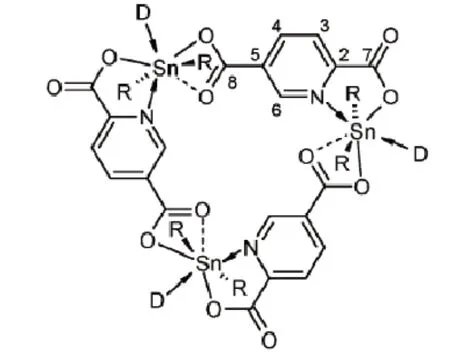
图1

图2
如图4 所示,MostafaM.Amin 利用2,6-吡啶二甲酸同二苯基二氯化锡反应得到了一个有趣结构,结构中Sn 原子与N 原子和Na 原子都进行了配位。
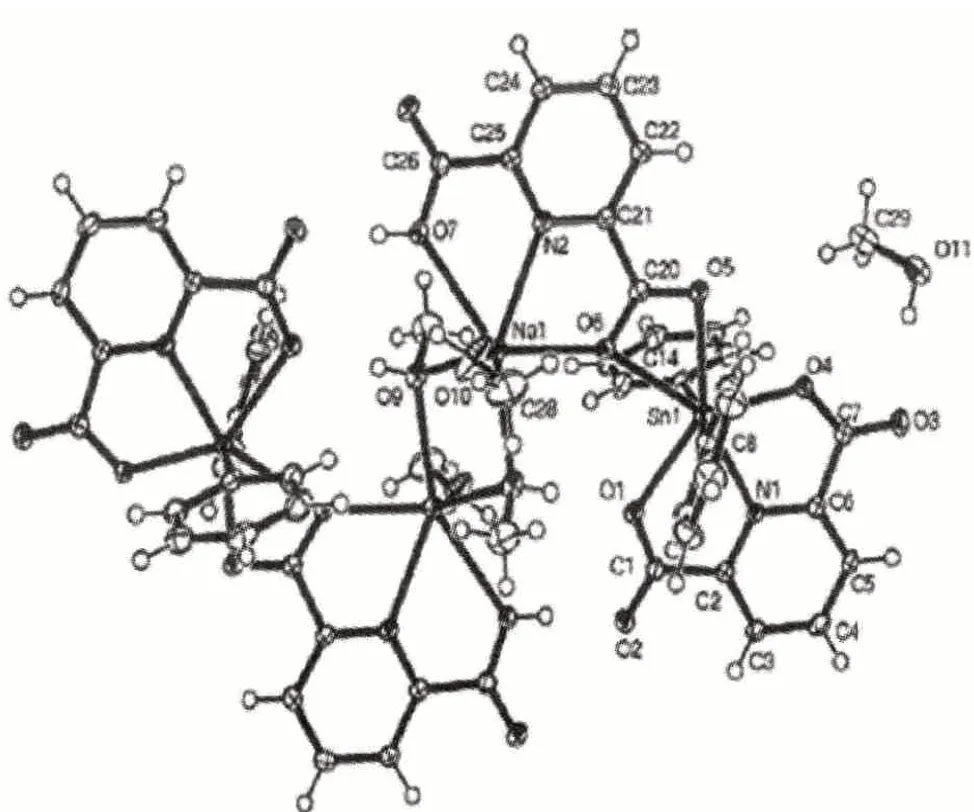
图3
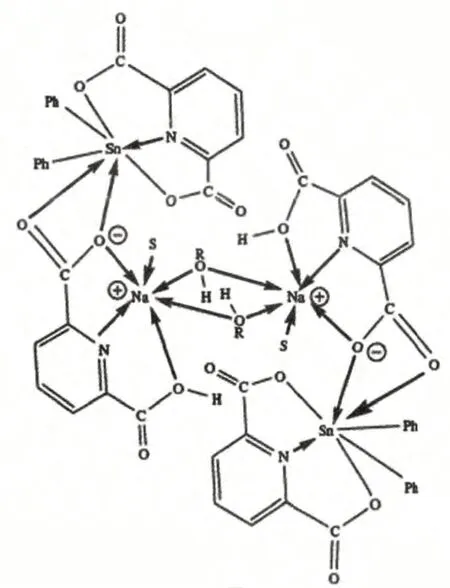
图4
而在一些反应中,溶剂分子如CH3OH、H2O 等也参与了配位。如图5 所示,在化合物[Bu2Sn(OOC5H4N2)2(H2O)]分子中,不仅吡啶环上的N原子、羧酸配体上的O 原子都和Sn 原子配位,溶剂水分子上的O 原子也和Sn 原子进行了配位,构成了七配位的五角双锥分子构型[14]。
如 图6 所 示,化 合 物[Ph3Sn(CH3OH)O2CC6H4CO2(CH3OH)Sn-Ph3]·(CH3OH)2中,由 于 甲醇分子参与配位,Sn 原子为五配位,而没有参与配位的CH3OH 分子同羧基上未参与配位的O 原子之间通过氢键作用把分子连成了二维网状结构[15]。
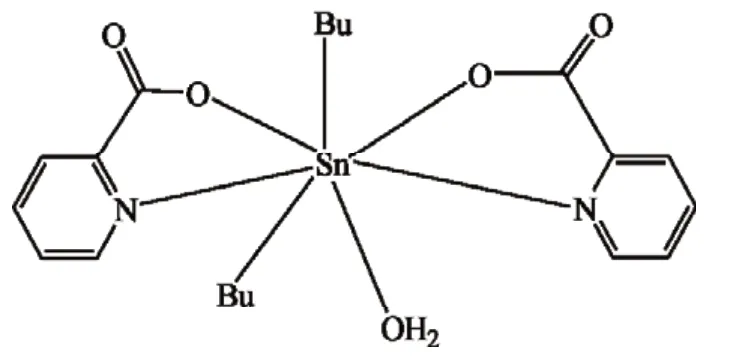
图5
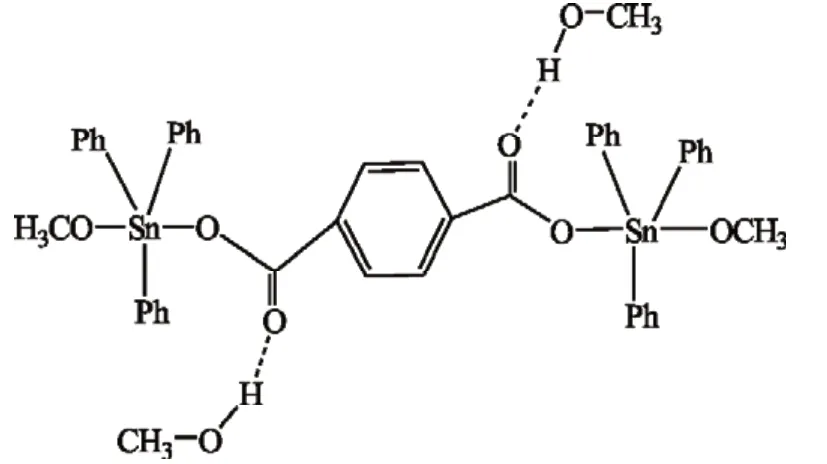
图6
对于其它含氧(或硫)的杂环羧酸与烃基锡的反应,研究人员也得到了一些化合物。比如3-吲哚乙酸与三丁基锡反应,得到了一个一维线性聚合物,Sn 原子的配位数为五,羧酸上的O 原子在轴向位置上,羧基单齿与Sn 原子配位[16]。而将2-噻吩甲酸与烃基锡反应,得到的化合物则是羧基以2 个O 原子双齿形式跟Sn 原子配位,锡原子为五配位数、三角双锥构型。如化合物三苯基锡-2-噻吩甲酸酯,羧基以2 个O 原子双齿与Sn 原子配位,Sn 原子为五配位的三角双锥构型[17](图7)。
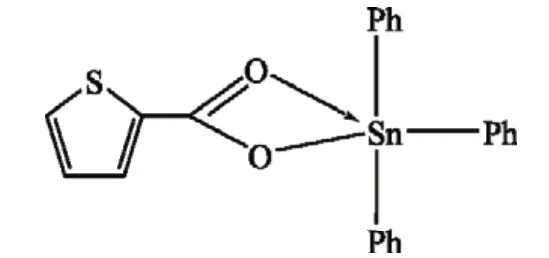
图7
而一些含氮杂原环和巯基的羧酸类化合物与烃基锡反应,得到了大环结构的有机锡配合物。例如,2-巯基尼克酸与二丁基二氯化锡进行自组装反应,得到了一个十八锡核的大环化合物[18](图8,为了清晰,锡原子上的丁基未画出)。 2-巯基-4-甲基-5-噻唑乙酸同二甲基二氯化锡、二丁基二氯化锡进行反应,分别得到了40 员和30 员的大环化合物[19-20](图9、10)。 4-(5-巯基四唑)苯甲酸与三甲基氯化锡更是经过复杂的自组装反应,得到了一个60 员大环的化合物[21](图11)。
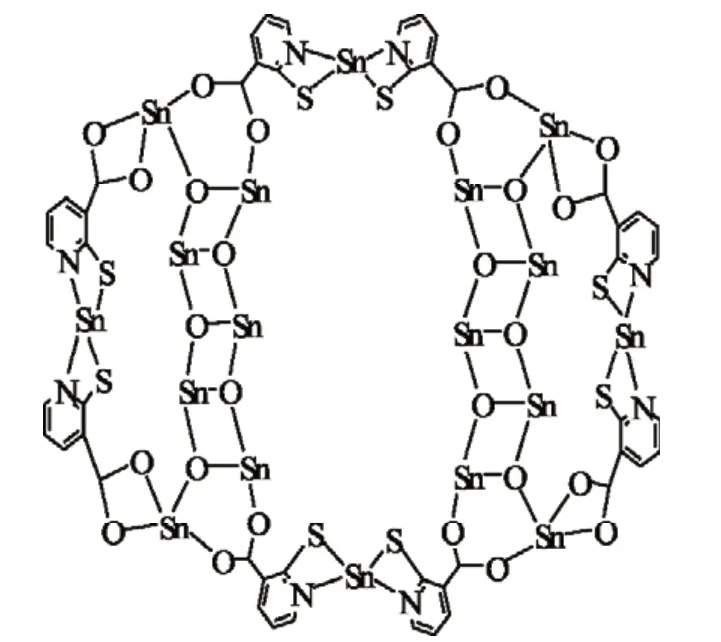
图8
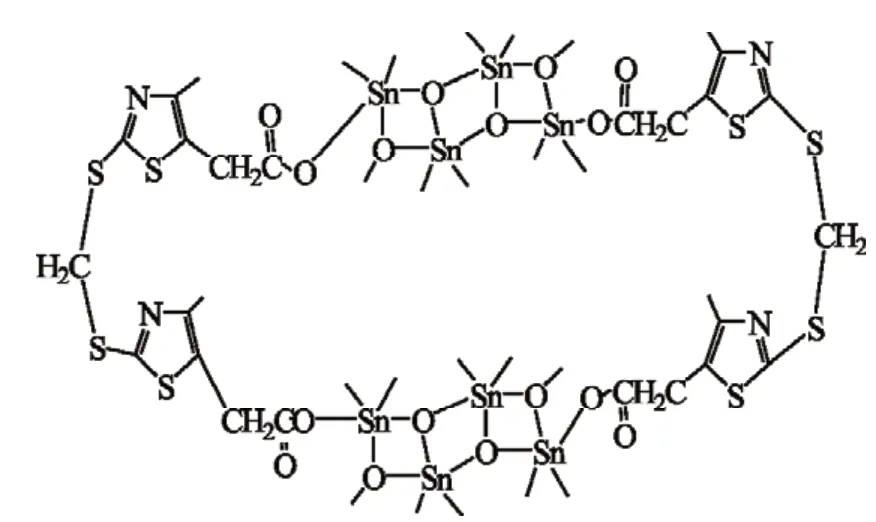
图9
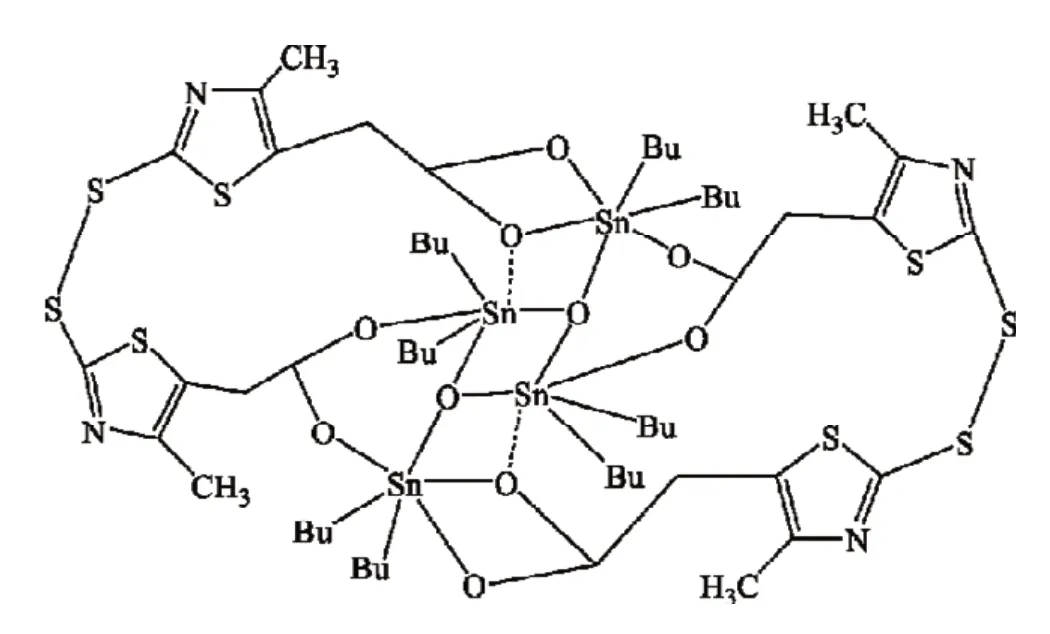
图10

图11
5-巯基四唑乙酸与三丁基三氯化锡通过溶剂热反应,得到了一个由36 员环组成的三维网状结构(图12)[22]。利用5,6-苯并咪唑二甲酸与三甲基氯化锡反应,得到了一个三维网状结构(图13)[23]。

图12
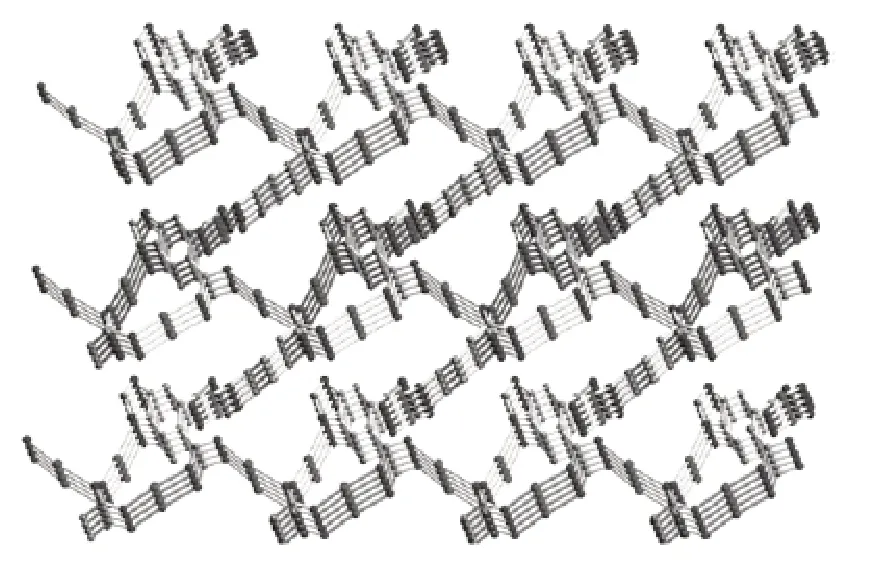
图13
2 含杂原子链状羧酸有机锡化合物的结构
从上面可以看出,关于芳香族的杂环羧酸的研究有很多已经很深入了,而链状羧酸与杂环羧酸在配位模式上以及在形成的化合物的结构上仍有一些不同。链状的双(羧甲基)三硫代碳酸酯作为配体分别与三烃基氯化锡反应,得到了一系列的二维网状空间结构的晶体[24]。图14 为双(羧甲基)三硫代碳酸酯与三甲基氯化锡反应得到的化合物。
以2,2’-硫代二乙醇酸为配体和三甲基氯化锡反应得到了一个由24 员环组成的二维网状结构,与三丁基氯化锡反应则得到了一个三维网状结构[25](图15)。
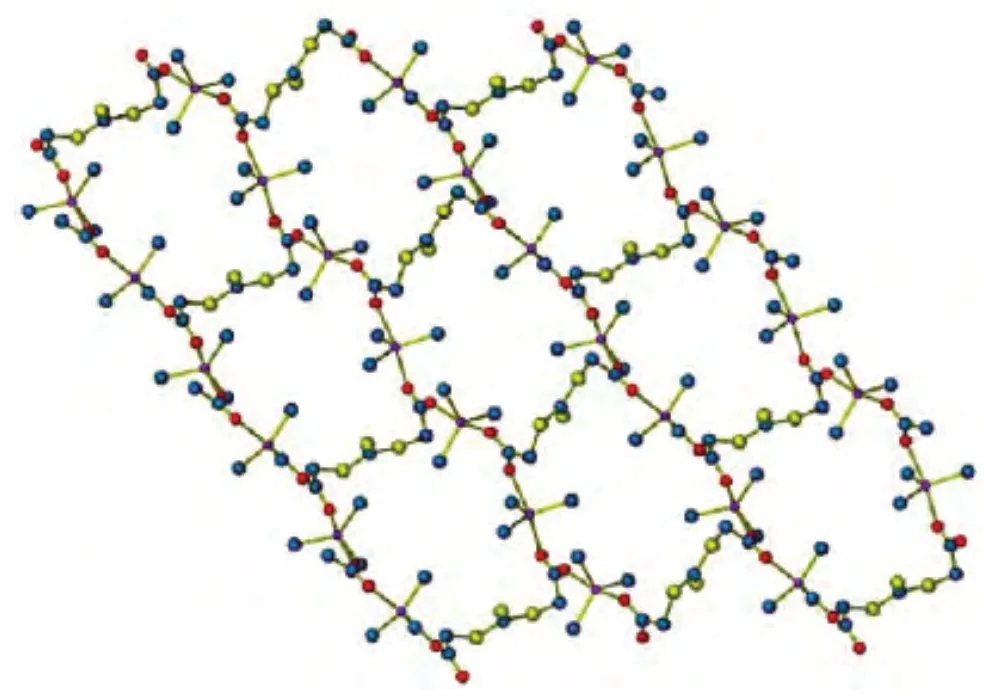
图14
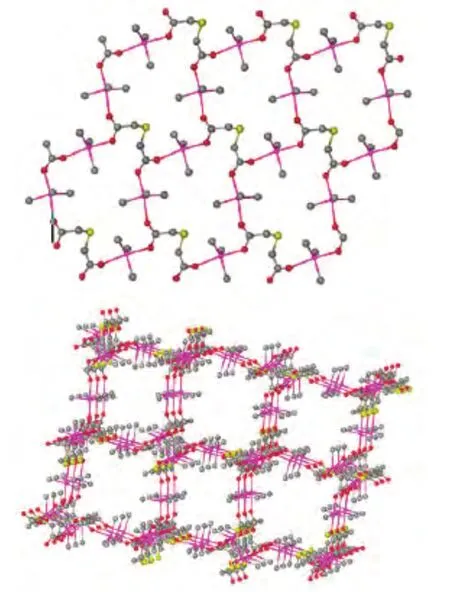
图15
3,3’-硫代二丙酸分别与三甲基氯化锡和三丁基氯化锡反应得到了2 个三维网状结构[25](图16)。
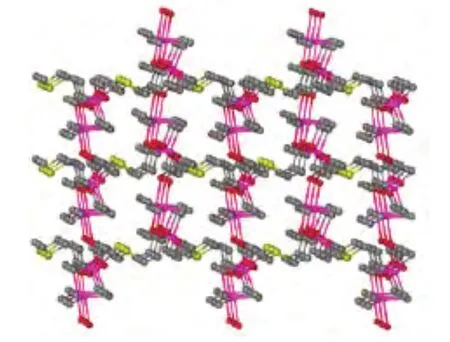
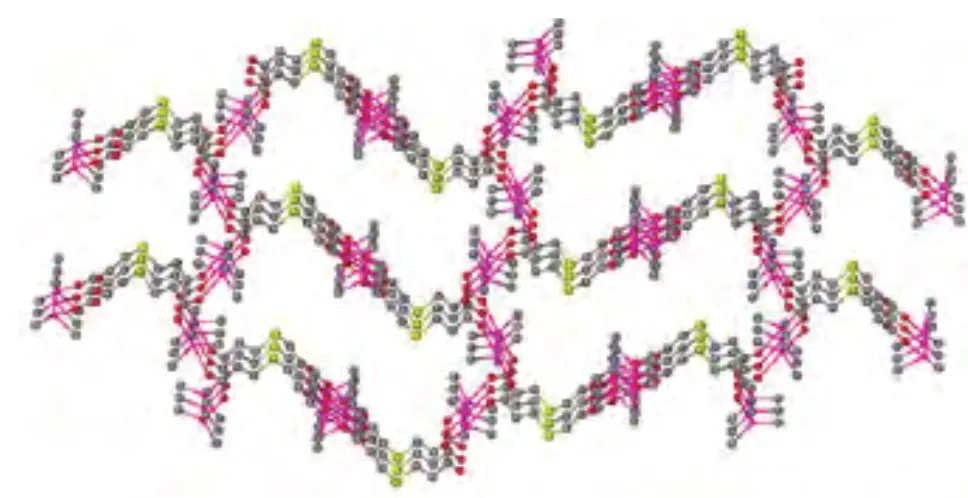
图16
由以上可以看出,不同的配体分别和不同的烃基锡反应,得到的化合物的空间结构也不一定相同,化合物的空间结构与烃基的空间位阻及配体的结构有着很大的关系。配体反应所得到的化合物都是二维和三维的网状结构,这说明具有柔性结构的链状羧酸是构建网状有机锡化合物的良好配体。
3 总结
含有氮、氧、硫等杂原子的羧酸作为配体与锡反应生成的有机锡化合物,结构复杂且与生命体关系紧密,研究这些有机锡化生物的结构不仅可以为揭示有机锡化合物的抗癌机理提供有用的信息,还能为开发新型药物提供可能的分子设计方案。对于含杂原子羧酸类有机锡化合物的合成研究、性质特点研究特别是生物活性研究在生命科学、医学领域依然具有广泛的应用前景。
[1] Casas J. S., Castineiras A., Condori F., et al. Structural characterization of n-methylpyridoxine (MePN; PN = vitamin B6)and Its diorganotin complexes [SnR2(MePN-H)]I (R = Me, Et, Bu and Ph)[J]. Eur. J. Inorg. Chem., 2003, 2003(15): 2790-2797.
[2] Yin H.D., Wang C.H., Ma C.L., et al. Synthesis, characterization and crystal structure of chlorodibenzyltin (Ⅳ) complex with dithiomorpholinocarbamate ligand[J]. Chinese J.Chem., 2002, 20(9): 913-916.
[3] Baul T.S.B., Dhar S., Rivarola E., et al. Synthesis and characterization of some dibutylbis{5-[(E)-2-(aryl)-1-diazenyl]-2-hydroxybenzoato}tin (Ⅳ) compounds. Toxicity studies of diand tri-organotin complexes on the second instar of Aedes aegypti mosquito larvae[J]. Appl. Organomet. Chem., 2003,17(5): 261-267.
[4] Yin H.D., Wang C.H., Wang Y., et al. Synthesis and crystal structure of bis[(2,6-pyridinedicarboxylato) (methanol) dibenzyltin (Ⅳ) [J].Chinese J. Chem., 2002, 20(8): 809-812.
[5] Dakternieks D., Duthie A., Smyth D.R., et al. Crystallographic report: dicyclopentyltin(Ⅳ) bis(2-quinaldinate) methanol solvate[J]. Appl. Organometallic Chem., 2003, 17(12): 960.
[6] Garcia-Zarracina R., Hopfl H. Structural characterization of dimethyl-and di-n-butyltin(Ⅳ) 2,3-pyridinedicarboxylate in solution and in the solid state[J]. Appl. Organometallic Chem., 2005, 19(4): 451-457.
[7] Azadmeher A., Amini M.M., Hadipour N., et al. Synthesis and structural characterization of diorganotin(Ⅳ) complexes with 2,6-pyridinedicarboxylic acid[J]. Appl. Organometallic Chem., 2008, 22(1): 19-24.
[8] Pettinari C., Marchetti F., Pettinari R., et al. Synthesis and characterisation of tin(Ⅳ) and organotin(Ⅳ) derivatives 2-{[(2-hydroxyphenyl)imino]methyl}phenol[J]. Inorg. Chim.Acta, 2001, 325(1/2): 103-114.
[9] Bouâlam M., Meunier-Piret J., Biesemans M., et al. Organotin(Ⅳ)compounds of 2-thiopyridine. Crystal and molecular structure of dicyclohexyltin(Ⅳ) bis(2-pyridylthiolate)[J]. Inorg. Chim. Acta,1992: 198-200, 249-255.
[10] Xu H.L., Yin H.D., Gao Z.J., et al. Catalytic oxidation of diorganotin(Ⅳ) carboxylates to mixed-ligand monoalkyltin(Ⅳ)carb oxylates by Ag+and structure characterization of the mixed-ligand monoalkyltin(Ⅳ) 2-pyridinecarboxylate(2-ClPhCH2)Sn(2-ClPhCO2)(O2CC5H4N-2)2[J]. J.Organomet.Chem.,2006, 691(15): 3331-3335.
[11] Neto J. L., de Lima G. M., Porto A.O., et al. Synthesis, characterisation and molecular structure of stannyl derivatives of molybdenum and iron[J]. J. Mol. Struct. 2006, 782(2/3):110-115.
[12] Garcla-Zarracino R., Hopfl H. A 3D hybrid network containing large spherical cavities formed through a combination of metal coordination and hydrogen bonding[J] Angew.Chem.Int. Ed. Engl., 2004, 43(12): 1507-1511.
[13] Chandrasekhar V., Thirumoorthi R., Azhakar R. New Structural Forms of Organostannoxane Macrocycle Networks[J]. Organometallics, 2007, 26(1): 26-29.
[14] Yin H.D., Wang C.H., Ma C.L. Synthesis, properties and crystal structure of seven-coordinated organotin complex[nBu2Sn(OOCC5H4N-2)2(H2O)][J]. Chinese J. Chem. 2002,20(12):1608-1611.
[15] Yin H.D., Ma C.L., Wang Y., et al. Synthesis and crystal structure of binuclear organotin (Ⅳ) complexes[Ph3Sn(CH3OH)O2CC6H4CO2(CH3OH)-SnPh3]·2 CH3OH and [Ph3SnS2CN(CH2CH2)2NCS2SnPh3]·2CH3OH[J]. Acta Chimica Sinica, 2002, 60 (5): 897-903.
[16] Yin H.D., Wang C.H., Ma C.L., et al. Synthesis and crystal structure of drum organooxotin clusters from heteroaromatic carboxylic acid [PhCH2Sn(O)(O2CC5H4N)]6and[PhCH2Sn(O)(O2CC4H3O)]6[J]. Chinese J. Chem., 2003,21(4): 452-459.
[17] Yin H.D., Wang C.H., Ma C.L., et al. One-dimensional infinite chain organotin compounds: synthesis and structural characterization of tr iphenyltin thiazole-2-carboxylate and triphenyltin 3-pyridinylcarboxylate[J].Chinese J. Chem., 2002, 20(10): 1129-1133.
[18] Ma C.L., Jiang Q., Zhang R.F., et al. Synthesis and crystal structure characterization o f a novel eighteen-tin-nuclear macrocyclic complex[J]. Dalton Trans., 2003(15): 2975-2978.
[19] Ma C.L., Sun J.F. A novel self-assembling synthesis and crystal structure of 40-memb ered macrocyclic complex containing eight-tin[J], Dalton Trans., 2004(12): 1785-1786.
[20] Zhang R.F., Sun J.F, Ma C.L. Synthesis and crystal structure of macrocyclic di-n-butyltin(Ⅳ) complex with 2-mercapto-4-methyl-5-thiazoleacetic acid, {[n-Bu2Sn(O2CCH2C4H3NS)SS(C4H3NSCH2CO2)Sn n-Bu2]O}2[J]. Inorg. Chim. Acta.,2004, 357(14): 4322-4326.
[21] Ma C.L., Wang Q.F., Zhang R.F. Self-assembly and characterization of a novel 2D network polymer containing a 60-membered organotin macrocycle[J]. Inorg. Chem.,2008, 47(16): 7060-7061.
[22] Ma C.L., Wang Q.F., Zhang R.F. Solvothermal synthesis and crystal structure of a novel 3D triorganotin polymer containing polyfunctional ligand 5-mercapto-1(H)-tetrazoleacetic acid[J].J.Inorg.Organomet.Polym.Mater., 2009, 19(2): 152-156.
[23] Ma C.L., Li Q.L., Zhang R.F. Syntheses and characterization of 1D, 2D and 3D organotin polymers with benzimidazole-5,6-dicarboxylic acid and trimethyltin chloride[J]. J. Inorg.Organomet.Polym. Mater., 2009, 19(2): 208-214.
[24] Ma C.L., Wang Q.F., Zhang R.F., et al. Syntheses and structural characterization of triorganotin derivatives of bis(carboxymethyl)trithiocarbonate: X-ray crystal structures of 2D network polymers[J]. J. Inorg. Organomet. Polym.Mater., 2008, 18(2): 229-235.
[25] Ma C.L., Zhu Q., Zhang R.F. Synthesis and structural characterization of triorganotin(Ⅳ) derivatives with 2,2′-thiodiglycolic acid and 3,3′-thiodipropionic acid[J]. J. Inorg.Organomet. Polym. Mater., 2012, 22(5):1206-1212.
